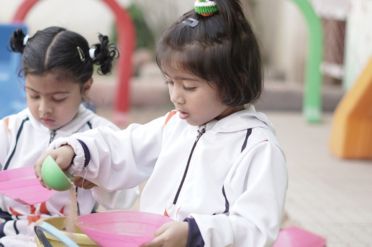Managing Screen Time for Young Children
As screens become more common, parents face the challenge of managing screen time in a way that supports healthy development. At Foundation Kindergarten, where "your child’s second home" is rooted in 32 years of excellence, we emphasize play-based, hands-on learning and limit screen exposure to encourage active exploration. Here are some helpful tips to manage screen time for your young child effectively.
Tips for Managing Screen Time
1. Set Clear Limits
Establishing daily screen time limits provides children with a predictable routine, helping them know when and how long they can engage with screens. The American Academy of Pediatrics suggests that preschool-aged children should have no more than one hour of screen time per day, ideally with high-quality educational content. Setting and sticking to these limits consistently prevents screen overuse and fosters a balanced routine that supports well-rounded development. At Foundation Kindergarten, we encourage screen-free play throughout the day, allowing children to focus on hands-on learning and discovery that support their cognitive, social, and motor skills.
2. Prioritize Screen-Free Activities
Introducing children to a variety of activities that stimulate their minds and bodies helps minimize their dependence on screens for entertainment. Physical play, creative art projects, reading, and sensory play all contribute to critical thinking, problem-solving, and imagination. For example, reading together promotes language development, while sensory play builds fine motor skills and hand-eye coordination. At Foundation Kindergarten, we focus on play-based activities that keep children engaged and excited about learning through real-world exploration. Encouraging screen-free time also improves focus, allowing children to immerse themselves in an activity without digital distractions.
3. Choose Quality Content and Make Screen Time Interactive
Not all screen time is equal. When children do engage with screens, choosing high-quality, educational content can make screen time more beneficial. Watching or interacting with content together helps turn screen time into an interactive experience where parents can ask questions, discuss what’s happening, and encourage active participation rather than passive viewing. This co-viewing approach helps children make connections between what they’re watching and their everyday lives, supporting comprehension and media literacy. By guiding their screen time, parents can help children process information better and encourage healthy viewing habits.
4. Create Screen-Free Zones and Times
Designating specific areas of the home, such as the dining table or bedrooms, as screen-free zones, creates a clear boundary between screen time and other important activities like family meals or bedtime. Similarly, establishing screen-free times, such as during meals or the hour before bed, can be effective in reducing screen time while creating meaningful moments for family interaction. This practice not only limits screen use but also signals to children that certain routines are sacred and do not involve screens, enhancing family bonding and promoting a sense of structure.
5. Encourage Outdoor Play and Physical Activity
Outdoor play allows children to move freely, develop motor skills, and engage in unstructured, imaginative play. Time spent outdoors helps counterbalance screen time, giving children fresh air, natural light, and physical exercise. Activities like running, playing ball, or exploring nature help children develop physical coordination and confidence, while also providing much-needed sensory experiences. Foundation Kindergarten emphasizes the importance of outdoor play as a core part of our curriculum, helping children build physical strength, social skills, and a sense of curiosity about the world around them.
6. Model Positive Screen Use
Children are natural imitators, and they learn a lot from observing their parents’ behaviour. By being mindful of your screen use, such as not scrolling on your phone during family time or setting boundaries on-screen usage for yourself, you set a positive example. Demonstrating responsible screen habits helps children understand that screens should be used with purpose and moderation. Modelling healthy screen use shows children that screens are just one part of life, reinforcing the importance of face-to-face interactions and active engagement.
7. Discuss Content and Encourage Critical Thinking
After screen time, talk to your child about what they watched or played. Engage them with questions like, "What was your favourite part?" or "What did you learn?" This approach encourages them to think critically and reflect on the content, helping to build comprehension and media literacy. Open discussions teach children to view content thoughtfully and help them separate fantasy from reality, a crucial skill for young viewers who are still learning to process and interpret media.
Benefits of a Balanced Approach
Balancing screen time with hands-on learning, interactive play, and outdoor activities supports a child's emotional, social, and cognitive development. A varied routine that includes screen-free activities promotes better focus, encourages problem-solving, and fosters independence. We believe in #earlylearningmatters, and we are dedicated to creating an environment where children can thrive through meaningful interactions and real-world learning. By incorporating these strategies, parents can ensure that screen time is a small, well-regulated part of their child’s day, fostering positive habits that will benefit them as they grow.
Balancing screen time with hands-on learning and outdoor play supports a child’s development. At Foundation Kindergarten, we prioritize interactive, screen-free learning experiences, where children learn through play and exploration because #earlylearningmatters.

